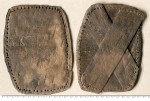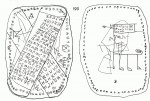 Russian archaeologists have unearthed a letter written on birch bark in Moscow’s historic Zaryadye district close to Red Square. The archaeological team from the Russian Academy of Sciences found the letter 13 feet below street level in a layer with more than 100 small and large artifacts dating to the 14th century.
Russian archaeologists have unearthed a letter written on birch bark in Moscow’s historic Zaryadye district close to Red Square. The archaeological team from the Russian Academy of Sciences found the letter 13 feet below street level in a layer with more than 100 small and large artifacts dating to the 14th century.
The first birch bark letters were discovered in 1951 in Novgorod, preserved in its heavy, waterlogged clay soil. Letters were scratched on the inner, trunk-facing side of the birch bark sheet using a stylus made of iron, bone or bronze. The letters were dated with a combination of stratigraphy (dating of the layers in which they were found), dendrochronology (tree ring dating) and palaeography (handwriting analysis) and linguistic analysis (examining the features of the text). They range in date from the 11th through the 15th century.
 The vast majority are letters from private individuals detailing the minutiae of their lives. Some are petitions of peasants to their lords. Some are debt lists, but since they open with the imperative “Take” it’s probable that they too were letters, probably of instruction on collecting the enumerated debt. One very special group of birch bark letters appear to be lessons and doodles. There are 17
The vast majority are letters from private individuals detailing the minutiae of their lives. Some are petitions of peasants to their lords. Some are debt lists, but since they open with the imperative “Take” it’s probable that they too were letters, probably of instruction on collecting the enumerated debt. One very special group of birch bark letters appear to be lessons and doodles. There are 17  drawings and notes by a young boy named Onfim. He lived in the 13th century and was around six or seven when he drew scenes of men on horseback, knights in battle, even himself as a fantastical beast next to alphabet and writing exercises. It’s a remarkable testament to a how highly literate this society was at all economic strata.
drawings and notes by a young boy named Onfim. He lived in the 13th century and was around six or seven when he drew scenes of men on horseback, knights in battle, even himself as a fantastical beast next to alphabet and writing exercises. It’s a remarkable testament to a how highly literate this society was at all economic strata.
Since that first discovery in 1951, more than 1000 birch bark letters have been found, almost all of them in Novgorod. The second greatest number, 45, were found in Staraya Russa, a town 60 miles south of Novgorod. Only nine other cities can claim birch bark letter discoveries. None were found in Moscow until 1988. It took 20 years before a second and third were unearthed at the foot of the Kremlin. None of those three quite followed the Novgorod standard. Moscow 1, as the 1988 find was dubbed, was a draft or copy of a property deed or claim. Moscow 2 had a small inscription that was hard to make out. Moscow 3 was a very long inventory of property of a Muscovite prince and it was written in ink, not scratched with a stylus. (Only two of the thousand plus Novgorod letters were written in ink.)
 That makes Moscow 4, the newly discovered piece, the first true Novgorod style birch bark letter found in the city. Like the overwhelming majority of the Novgorod ones, this is a private letter. The strip of bark has the smooth surface and carefully cut edges indicating it was specifically prepared for use as stationary. Each letter is printed very clearly and distinctly along the length of the fibers, as they are in Novgorod. The other Moscow letters were written against the grain.
That makes Moscow 4, the newly discovered piece, the first true Novgorod style birch bark letter found in the city. Like the overwhelming majority of the Novgorod ones, this is a private letter. The strip of bark has the smooth surface and carefully cut edges indicating it was specifically prepared for use as stationary. Each letter is printed very clearly and distinctly along the length of the fibers, as they are in Novgorod. The other Moscow letters were written against the grain.
The letter is a sad one. Addressed simply to “Sir,” it tells of the writer’s misfortunes while traveling to Kostroma, a city 217 miles to the northeast that was part of the Grand Duchy of Moscow. The writer was detained along with a certain Yuri and his mother by someone “who had the right to do so.” This person, likely an official of some kind, took 13 bel (a relatively small denomination of currency in medieval Russia) from them and then another three. Finally the author had to pay 20 and a half bel more to buy their freedom. The total of 36.5 bel was a signficant amount of money back then. Since it appears the captor had legal rights, this may have been the repayment of a debt with extra tacked on for interest.
Every Novgorod birch bark letter find is exciting, but the rarity of a Moscow find and the precise printing of this letter make it of particular interest to archaeologists. It will be conserved to ensure its long-term survival and studied further at the Russian Academy of Sciences.
Most of the birch bark letters have been uploaded to an online database. The website is down right now but it was working earlier. From what I could gather when it was up, it hasn’t been updated for a while so it’s not quite a complete record. Still, you can photographs of each letters in high resolution, plus transcriptions and translations.